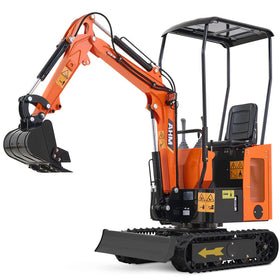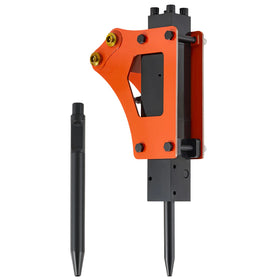Operating a mini excavator for the first time can feel like learning to handle a powerful but unfamiliar tool. You could be facing a steep slope in your backyard project or working near existing structures, and each of these situations demands specific techniques to keep you safe and your work efficient. From unstable ground conditions to tricky hydraulic controls, knowing what could go wrong helps you get it right.

1. Understanding Mini Excavator Weights & Soil Assessment
Mini excavator packs serious power in a compact frame, weighing anywhere from 3,500 to 12,000 pounds. Lighter models like AHM's 1-ton mini excavator offer excellent maneuverability while maintaining stability. Regardless of weight, you'll need to assess ground conditions carefully. Knowing how much a mini excavator weighs is crucial for stable operation. The heavier your machine, the more carefully you need to assess ground conditions.
Different soil types present unique challenges: clay soils become dangerously slick when wet, sandy soils might lack proper compaction, and organic soils can hide pockets of weakness. Stay alert for warning signs like standing water, recent fill areas, or ground that feels spongy under foot traffic.
Particularly risky conditions include:
- Recently filled trenches that haven't properly settled
- Areas after heavy rain where water hasn't fully drained
- Sites with underground utilities where soil has been disturbed
- Ground near septic systems or drainage fields
- Thawing permafrost or frozen ground
Test questionable areas by applying light pressure with your bucket before committing the machine's full weight. If you notice the tracks leaving deep impressions or feel any unusual sinking, reassess your approach or consider ground protection mats for better weight distribution.
2. How steep of a slope can a mini excavator handle?
Mini excavator can handle slopes, but there's a science to it. The maximum safe angle is 30 degrees, which aligns with OSHA's guidelines for preventing tip-over incidents. If you're unsure, think of it this way: if you have trouble walking up the slope without using your hands, it's probably too steep for safe operation.
For downhill work
Position yourself so you're facing downhill with the blade lowered slightly above ground level (about 8-12 inches). This gives you better control and prevents unwanted sliding.
For uphill work
Keep your blade facing uphill and positioned 8-12 inches above the ground. If something feels off, immediately lower the blade to the ground - it acts like an anchor in emergencies.

Even with lighter machines like AHM's mini excavator, never exceed the 30-degree slope limit. The machine's weight distribution and engine performance from its Kubota powerplant help maintain stability, but operator caution remains essential.
3. Wet Ground Operations
When working in wet conditions, you should always keep your tracks above water level to protect vital parts like your radiator. After splashing through wet conditions, show your machine some love with lubricant on any parts that got soaked – it'll prevent rust and keep everything moving smoothly.

Those rubber tracks need extra attention when things get slick. While they're great for most jobs, they won't grip as well as steel tracks on wet surfaces, especially when you're turning. Take it slow and steady – no sharp turns – and you'll keep your machine stable even when the ground's working against you.
4. Managing Common Challenges
Stuck in the Mud Solution
If you find your mini excavator stuck in mud (which happens to even experienced operators), here's your step-by-step rescue plan:
1. If only one track is stuck
- Position the arm and boom at 90-110 degrees
- Place the bucket firmly on solid ground
- Use the bucket to lift the trapped side
- Insert a sturdy plank under the raised track
- Drive forward onto the plank to escape
2. If both tracks are stuck
- Follow the same arm and boom positioning
- Lift the entire machine using the bucket
- Place planks under both tracks
- Use the bucket as leverage while moving forward

Safe Loading of Mini Excavators on Trailers
Loading a mini excavator requires careful attention to both the trailer setup and machine positioning. The process starts well before driving the excavator onto the trailer.
1. Before Loading:
- Park trailer on flat, level ground
- Engage truck and trailer parking brakes
- Place wheel chocks on trailer tires
- Check ramps - need 6 inches clearance on each side of tracks
- Remove mud or debris from excavator tracks
2. Loading Steps:
- Line up excavator straight with ramps, dozer blade forward
- Keep bucket 8-12 inches above ramps to prevent catching
- Drive slowly, tracks centered
- Lower boom gradually while moving up deck
- Once on deck, set all attachments flat
3. Securing:
- Use four tie-down points: two front, two rear
- Attach only to marked frame spots
- Chain or strap until machine stays firm when pushed
- Double check all connections before transport
5. Safe Excavation Practices
Before You Dig
Before your bucket hits the dirt, make a quick call to utility services – it could save you from hitting a power line or gas pipe hiding underground. Once you know what's down there, mark those spots clearly. And here's a tip that could save your day: keep your distance from steep edges (about two machine lengths back). The ground can give way without warning, so watch for telltale signs like cracks or soil that's settling oddly – they're nature's way of saying "stay back."
Working Near Buildings
Keep your distance from buildings – about 1.5 times your excavator's reach is a good rule. Before you start, scan those walls and foundations for any existing damage.
Secondly, never undercut walls or foundations, which means don't dig deeper than the base of any structure. One wrong move can destabilize entire buildings. And while you're looking down, don't forget to look up – keep your bucket at least 20 feet clear of any power lines overhead.
When working in tight spaces or residential areas, compact excavators like AHM's model, Kubota engine mini excavator, provide the precision control needed for delicate operations. Their lighter footprint also reduces the risk of ground compression.
6. Hydraulic System Management
Daily Checks
Start each day with a quick inspection of your hydraulic system. Think of it as checking your car's oil – look for any spots under the machine or wet areas around cylinders and hoses. Catching these early keeps your machine running smoothly.
Remember to work within your machine's limits. Pushing cylinders to their max is like stretching a rubber band too far, because eventually something's got to give. And never try lifting the whole machine with the dozer blade – that's asking for trouble.
Emergency Handling
If your machine starts acting up – maybe jerky movements or strange noises – trust your instincts and stop. Ease any raised attachments down slowly, keeping the engine at idle. It's like landing a plane – you want a gentle touchdown, not a crash landing.
Stay put in your cab until everything's completely still. Those hydraulic lines pack enough pressure to cause serious harm if they break. This is one repair job that's best left to the pros – certified technicians know how to handle these complex systems safely.

Safety and skill go hand in hand when operating a mini excavator. Take time to understand your machine, respect its limits, and stay alert to your surroundings. With these guidelines in mind, you're ready to tackle your next project with confidence.







